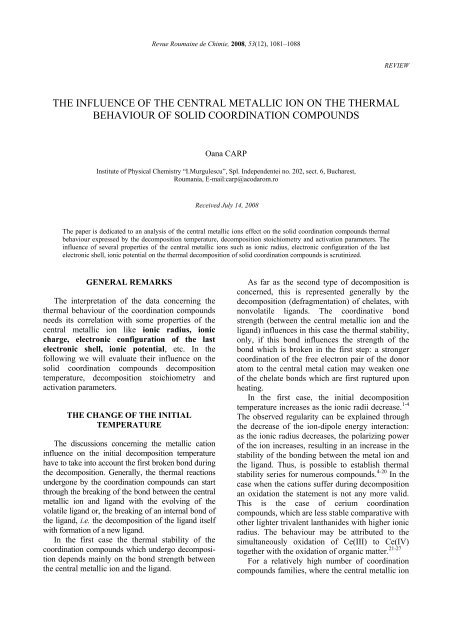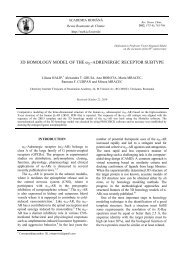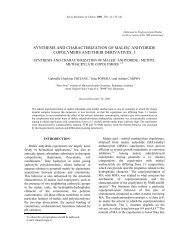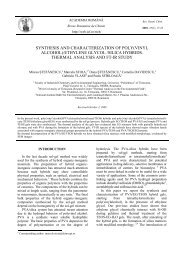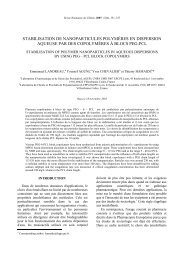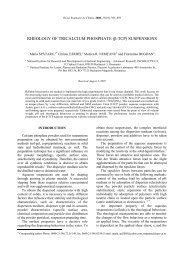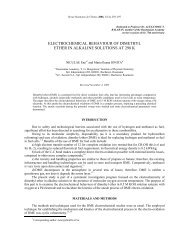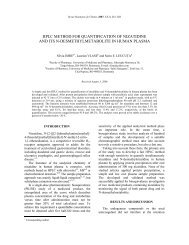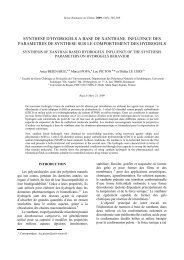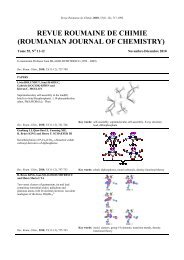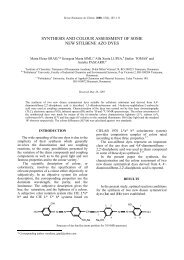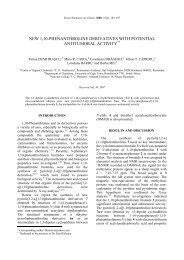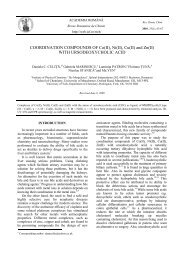Art 01.pdf - Revue Roumaine de Chimie
Art 01.pdf - Revue Roumaine de Chimie
Art 01.pdf - Revue Roumaine de Chimie
You also want an ePaper? Increase the reach of your titles
YUMPU automatically turns print PDFs into web optimized ePapers that Google loves.
<strong>Revue</strong> <strong>Roumaine</strong> <strong>de</strong> <strong>Chimie</strong>, 2008, 53(12), 1081–1088<br />
REVIEW<br />
THE INFLUENCE OF THE CENTRAL METALLIC ION ON THE THERMAL<br />
BEHAVIOUR OF SOLID COORDINATION COMPOUNDS<br />
Oana CARP<br />
Institute of Physical Chemistry “I.Murgulescu”, Spl. In<strong>de</strong>pen<strong>de</strong>ntei no. 202, sect. 6, Bucharest,<br />
Roumania, E-mail:carp@acodarom.ro<br />
Received July 14, 2008<br />
The paper is <strong>de</strong>dicated to an analysis of the central metallic ions effect on the solid coordination compounds thermal<br />
behaviour expressed by the <strong>de</strong>composition temperature, <strong>de</strong>composition stoichiometry and activation parameters. The<br />
influence of several properties of the central metallic ions such as ionic radius, electronic configuration of the last<br />
electronic shell, ionic potential on the thermal <strong>de</strong>composition of solid coordination compounds is scrutinized.<br />
GENERAL REMARKS<br />
The interpretation of the data concerning the<br />
thermal behaviour of the coordination compounds<br />
needs its correlation with some properties of the<br />
central metallic ion like ionic radius, ionic<br />
charge, electronic configuration of the last<br />
electronic shell, ionic potential, etc. In the<br />
following we will evaluate their influence on the<br />
solid coordination compounds <strong>de</strong>composition<br />
temperature, <strong>de</strong>composition stoichiometry and<br />
activation parameters.<br />
THE CHANGE OF THE INITIAL<br />
TEMPERATURE<br />
The discussions concerning the metallic cation<br />
influence on the initial <strong>de</strong>composition temperature<br />
have to take into account the first broken bond during<br />
the <strong>de</strong>composition. Generally, the thermal reactions<br />
un<strong>de</strong>rgone by the coordination compounds can start<br />
through the breaking of the bond between the central<br />
metallic ion and ligand with the evolving of the<br />
volatile ligand or, the breaking of an internal bond of<br />
the ligand, i.e. the <strong>de</strong>composition of the ligand itself<br />
with formation of a new ligand.<br />
In the first case the thermal stability of the<br />
coordination compounds which un<strong>de</strong>rgo <strong>de</strong>composition<br />
<strong>de</strong>pends mainly on the bond strength between<br />
the central metallic ion and the ligand.<br />
As far as the second type of <strong>de</strong>composition is<br />
concerned, this is represented generally by the<br />
<strong>de</strong>composition (<strong>de</strong>fragmentation) of chelates, with<br />
nonvolatile ligands. The coordinative bond<br />
strength (between the central metallic ion and the<br />
ligand) influences in this case the thermal stability,<br />
only, if this bond influences the strength of the<br />
bond which is broken in the first step: a stronger<br />
coordination of the free electron pair of the donor<br />
atom to the central metal cation may weaken one<br />
of the chelate bonds which are first ruptured upon<br />
heating.<br />
In the first case, the initial <strong>de</strong>composition<br />
temperature increases as the ionic radii <strong>de</strong>crease. 1-4<br />
The observed regularity can be explained through<br />
the <strong>de</strong>crease of the ion-dipole energy interaction:<br />
as the ionic radius <strong>de</strong>creases, the polarizing power<br />
of the ion increases, resulting in an increase in the<br />
stability of the bonding between the metal ion and<br />
the ligand. Thus, is possible to establish thermal<br />
stability series for numerous compounds. 4-20 In the<br />
case when the cations suffer during <strong>de</strong>composition<br />
an oxidation the statement is not any more valid.<br />
This is the case of cerium coordination<br />
compounds, which are less stable comparative with<br />
other lighter trivalent lanthani<strong>de</strong>s with higher ionic<br />
radius. The behaviour may be attributed to the<br />
simultaneously oxidation of Ce(III) to Ce(IV)<br />
together with the oxidation of organic matter. 21-27<br />
For a relatively high number of coordination<br />
compounds families, where the central metallic ion
1082 Oana Carp<br />
is changed, the thermal stability as expressed by the<br />
initial <strong>de</strong>composition temperature does not follow the<br />
Irving-Williams 28 series or<strong>de</strong>r concerning the thermal<br />
stability of the coordination compounds in<br />
solution. 29-36 These changes which could lead even to<br />
inverse series of thermal stabilities, are <strong>de</strong>terminate<br />
by various peculiarities introduced by the presence of<br />
the solid state. Among them, the strong<br />
intermolecular bonds which operate in solid state 36-38<br />
represent an important factor. On the other hand,<br />
when the electrostatic effects prevail, the or<strong>de</strong>r is<br />
preserved. 39-40<br />
As example, we mention the coordination<br />
compounds series containing Co(II), Ni(II) and<br />
Cu(II) cations. The stability or<strong>de</strong>r of complexes in<br />
solution is Co
Thermal behaviour of solid coordination compounds 1083<br />
An interesting example is represented by the<br />
thermal <strong>de</strong>composition of dialkyldithiocarbamato<br />
Ni(II) and Co(II) complexes, M[S 2 CN(C 3 H 5 ) 2 ]. 91 In<br />
the case of Ni compound, the thermal<br />
<strong>de</strong>composition to NiS occurs by initial elimination<br />
of S 2 CN(C 3 H 5 ) 2 , C 3 H 5 and subsequent loss of<br />
C 3 H 5 -N=C=S (reaction 1). On the other hand, the<br />
pyrolysis to CuS occurs via<br />
[CuS 2 CN(C 3 H 5 ) 2 ][SCN-C 3 H 5 ] and by sequential<br />
elimination of S 2 CN(C 3 H 5 ) 2 followed by<br />
elimination of RCN (reaction 2):<br />
232-360<br />
Ni[S 2<br />
CN(C 3<br />
H 5<br />
) 2<br />
] o C<br />
460-600<br />
2 NiS 2<br />
CN(C 3<br />
H 5<br />
) o C<br />
2 NiS + C 3<br />
H 5<br />
-S 2<br />
CN(C 3<br />
H 5<br />
) 2<br />
-C 3<br />
H 5<br />
N C S<br />
(1)<br />
(1)<br />
Cu[S 2<br />
CN(C 3<br />
H 5<br />
) 2<br />
] 2<br />
Cu[S 2<br />
CN(C 3<br />
H 5<br />
) 2<br />
][SCN(C 3<br />
H 5<br />
) 2<br />
] Cu[S 2<br />
CN(C 3<br />
H 5<br />
) 2<br />
][S 2<br />
CN(C 3<br />
H 5<br />
)]<br />
- C 3<br />
H 5<br />
- S<br />
- C 3<br />
H 5<br />
- S<br />
Cu[S 2<br />
CN(C 3<br />
H 5<br />
) 2<br />
][SCN(C 3<br />
H 5<br />
)]<br />
(2)<br />
Cu[SCN(C 3<br />
H 5<br />
)]<br />
- (C 3<br />
H 5<br />
) 2<br />
CNS 2<br />
- C 3<br />
H 5<br />
CN<br />
(2)<br />
CuS<br />
The thermal <strong>de</strong>composition of metal complexes<br />
with 3,5-pyrazoledicarboxylate ligand,<br />
[Mpz(COO) 2 (H 2 O) 2 ] (M(II)=Mn, Co, Ni, Cu or Zn,<br />
pz(COO) 2 =3,5–pyrazoledicarboxylate lead to metal<br />
oxi<strong>de</strong>s as final <strong>de</strong>composition products, except<br />
manganese compound from which manganese<br />
carbonate is obtained. 92 The partial ionic character<br />
of manganese compound may be responsible for<br />
this behaviour. 93<br />
Depending on the present metallic cation, the<br />
thermal <strong>de</strong>composition of some bivalent transition<br />
coordination compounds containing bromi<strong>de</strong> and<br />
pyridine: [MBr 2 (py) 2 ] 94 , [MBr 2 (an) 2 ] 95 [MBr 2 (pcaln)<br />
2 ] 96 and [MBr m (ttp) n ] 97 where M(II)= Mn, Co,<br />
Ni, Cu or Zn, py=pyridine, an=aniline p-caln=4-<br />
chloraniline and ttp=triphenylphosphine, m=1 or 2,<br />
n=1.5, 2 or 3, is characterized by different number<br />
of <strong>de</strong>composition steps and different<br />
<strong>de</strong>composition stoichiometries. As example we<br />
<strong>de</strong>tailed the thermal <strong>de</strong>gradation of [MBr 2 (py) 2 ]<br />
compounds, which <strong>de</strong>composes in two stages (Co,<br />
Cu and Zn compounds) and, three (Mn and Ni<br />
ones). The ligand is evolved in the first step (Co,<br />
Ni and Zn compounds) or in the first two steps<br />
(Mn compound) or all the ligand and part of the<br />
bromi<strong>de</strong> in the first step (Cu compound). The<br />
compounds containing Co, Ni, Cu and Zn lost part<br />
of the metal in the last step (up to 950 o C).<br />
The thermal <strong>de</strong>composition of complex malates<br />
(Fe(III), M (II)=Zn or Ni) occurs also through a<br />
different number of <strong>de</strong>composition steps and via<br />
different <strong>de</strong>composition intermediates. 98 While <strong>de</strong><br />
Fe(III) and Ni(II) coordination compounds form<br />
during <strong>de</strong>composition an oxoacetate intermediate,<br />
for Zn(II) an hidroxycarbonate one is evi<strong>de</strong>nced.<br />
THE CHANGE OF THE VALUES<br />
OF THE ACTIVATION PARAMETERS<br />
The change of the activation parameters,<br />
corresponding to some thermal <strong>de</strong>compositions<br />
when the central metallic ions is changed, was<br />
investigated for a limited number of solid<br />
coordination compounds. 99-107<br />
The metallic ion-volatile ligand bond length<br />
could represent the main factor which <strong>de</strong>termines<br />
the value of the <strong>de</strong>composition activation energy.
1084 Oana Carp<br />
An inverse <strong>de</strong>pen<strong>de</strong>nce between radius and<br />
activation energy is valid only in the case of the<br />
coordination compounds with rigid coordination<br />
polyhedron and, only for the <strong>de</strong>composition which<br />
occurs through similar mechanisms and begin with<br />
the breaking of metallic ion-ligand bond. 108-120<br />
The possibility of oxidation/reduction of the<br />
metallic cation represents another cause of<br />
activation parameter changes. So during the<br />
<strong>de</strong>composition in inert atmosphere of some rare<br />
earth (Ln(III)= La, Nd, Dy or Eu) picrates and<br />
2,2’-dithiobis (pyridine-N-oxi<strong>de</strong>) compounds, the<br />
obtained results are similar for La(III), Nd(III) and<br />
Dy(III), but different in the case of Eu(III). 121 Such<br />
a difference arises due to the +2 oxidation number,<br />
which may have been caused by the nitrogen<br />
atmosphere with an eventual oxygen removal.<br />
The value of the <strong>de</strong>composition activation<br />
energy <strong>de</strong>pends strongly on the covalent/ionic<br />
character of the M-X bond. 58,122 Higher activation<br />
energy is obtained at a higher covalent character of<br />
metallic ion-ligand bond. So, for the coordination<br />
compounds of chlorometylated poly(styrene)-PAN<br />
resin (PAN=α-pyridylazo-β-naphthol) with some<br />
transition metal ions, the calculated<br />
thermodymanic parameters and activation energy<br />
confirm a stability or<strong>de</strong>r Cu
Thermal behaviour of solid coordination compounds 1085<br />
pyrazine<br />
N<br />
N<br />
4,4- bipyridine<br />
N<br />
N<br />
quinoline<br />
8-hydroxyquinoline (R=OH, Hox)<br />
8-aminoquinoline (R=-NH 2 )<br />
o-phenanthroline (phen) (1,10)<br />
N<br />
;<br />
R<br />
N<br />
Sulfur containing compounds<br />
Dialkylthiocarbamate<br />
R 1 =R 2 =-C 3 H 5<br />
Phosphorous containing compound<br />
triphenylphosphine<br />
N<br />
(R 1 R 2 )NSSH<br />
N<br />
P<br />
tripoidal phosphine (Htripos)<br />
Nitrogen-oxygen containing comopunds<br />
dimethylformami<strong>de</strong><br />
orotic acid<br />
C H 3<br />
H<br />
O<br />
C<br />
O<br />
C<br />
N<br />
H 2<br />
C PPh<br />
C PPh<br />
C H2 PPh<br />
H 2<br />
CH 3<br />
CH 3<br />
OH<br />
acetylsalicylhydroxamic acid<br />
O<br />
N<br />
H<br />
NH<br />
HN<br />
O<br />
OH<br />
O<br />
O<br />
CH 3<br />
O<br />
citronellal anthranilic (X=-H)<br />
citronellal-5-bromoanthranilic (X=-Br)<br />
CH 2<br />
C N<br />
H<br />
CH 2<br />
COOH<br />
X<br />
1,4-di-(1-hydroxyimino-2-phenyl-2-oxoethylamino)benzene<br />
O<br />
N<br />
OH<br />
HO<br />
N<br />
O<br />
C<br />
C<br />
N<br />
N<br />
C<br />
C<br />
H<br />
H
1086 Oana Carp<br />
picric acid<br />
OH<br />
O 2<br />
N<br />
NO 2<br />
NO 2<br />
chlorometylated polystyrene-α-pyridylazo-β-naphtol<br />
C CH C CH<br />
H H2 2<br />
C CH<br />
H 2<br />
a<br />
C CH C CH C CH<br />
H 2<br />
H 2 H 2<br />
b c d e<br />
CH 2 Cl<br />
CH 2<br />
-<br />
O Cl<br />
+<br />
N N N<br />
CH 2<br />
H<br />
O<br />
N<br />
N<br />
N<br />
Sulfur-nitrogen and sulfur-nitrogen-oxygen<br />
containing compounds<br />
3-N-methyl-morpholino-4-amino-5-mercapto-1,2,4-<br />
triazole<br />
O N C<br />
H2<br />
NH 2<br />
SH<br />
N<br />
N<br />
Aminohydroxylated compounds<br />
8-hydroxyquinoline (Hox)=<br />
8-aminoquinoline<br />
N<br />
N<br />
OH<br />
NH 2<br />
8-hydroxyquinoline (Hox)<br />
N<br />
noradrenaline (R=H)<br />
drenaline (R=-CH 3 )<br />
HO<br />
Carbonylic compounds<br />
malonami<strong>de</strong> CH 2 (CONH 2 ) 2<br />
Aliphatic acids<br />
monochloracetic acid<br />
dichloracetic acid<br />
ClCH 2 COOH<br />
Cl 2 CHCOOH<br />
cyclopropane-1,1 dicarboxylic acid<br />
HOOC COOH<br />
HO<br />
OH<br />
OH<br />
N<br />
H<br />
R<br />
4-methylbenzyli<strong>de</strong>nepyruvate<br />
4-CH 3 -C 6 H 4 -CH=CH-COCOOH<br />
oxalic acid<br />
HOOC-COOH<br />
malic acid<br />
HOOC-CHOH-CH 2 -COOH<br />
3 methylglutaric acid HOOCCH 2 CH(CH 3 )CH 2 COOH<br />
Aromatic acids<br />
4-methoxybenzoic acid<br />
COOH<br />
dimethoxybenzic acid (3,5-)<br />
O CH<br />
COOHO CH 3<br />
3<br />
H 3 C O
Thermal behaviour of solid coordination compounds 1087<br />
REFERENCES<br />
1. H. Icbudak, V. T.Yilmaz and H. Ölmez, J. Therm. Anal.<br />
Cal., 1998, 53, 843.<br />
2. K. Nagase, Bull. Chem. Soc. Jpn., 1973, 46, 144.<br />
3. W. Ferenc and B.Bocian, J. Therm. Anal. Cal., 1998, 52,<br />
543.<br />
4. B. Ptaszyński and A. Zwilińska, J. Therm. Anal. Cal.,<br />
2003, 74, 237.<br />
5. S. U. Din and M. Umar, J. Therm. Anal. Cal., 1999, 58, 61.<br />
6. G. G. Mohamed, F. A. Nour El-Dien and N. E. A. El-<br />
Gamel, J. Therm. Anal. Cal., 2002, 67, 135.<br />
7. M. Ba<strong>de</strong>a, R. Olar, E. Cristurean, D. Marinescu, M.<br />
Brezeanu, M. Balasoiu and E. Segal, J. Therm. Anal.<br />
Cal., 1999, 58, 103.<br />
8. A. G. Souza, M. L. A. Tavares, D. M. A. Melo, M. M.<br />
Conceiçã, J. G. P. Espinola and C. Airoldi, J. Therm.<br />
Anal. Cal., 2002, 67, 351.<br />
9. M. A. S. Carvalho Filho, N. S. Fernan<strong>de</strong>s, M. I. G. Leles,<br />
R. Men<strong>de</strong>s and M. Ionashiro, J. Therm. Anal. Cal., 2000,<br />
59, 669.<br />
10. P. Naumov, G. Jovanovski, V. Jordanovska and B.<br />
Boyanov, J. Serb. Chem. Soc., 1999, 64, 609.<br />
11. P. Naumov, V. Jordanovska, O. Grupče, B. Boyanov and<br />
G. Jovanovski, J. Therm. Anal. Cal., 2001, 65, 59.<br />
12. P. Naumov, O. Grupče, V. Jordanovska, B. Boyanov and<br />
G. Jovanovski, J. Therm. Anal. Cal., 2001, 65, 871.<br />
13. P. Naumov, V. Jordanovska, B. Boyanov and G.<br />
Jovanovski, J. Therm. Anal. Cal., 2001, 66, 469.<br />
14. H. D. Wang, Y. Chen, Y. T. Li and X. C. Zeng,<br />
Thermochim. Acta, 2004, 412, 97.<br />
15. S. T. Breviglieri, E. T. G. Cavalheiro and G. O. Chierice,<br />
Thermochim. Acta, 2000, 356, 79.<br />
16. M. A. S. Carvalho Filho, N. S. Fernan<strong>de</strong>s, F. L.<br />
Fertonani and M. Ionasshiro, Thermochim. Acta, 2003,<br />
398, 93.<br />
17. G. Singh, S. P. Felix and D. K. Pandy, Thermochim.<br />
Acta, 2004, 411, 61.<br />
18. V. T. Yilmaz, M. Sülü and T. K. Yazicilar, Thermochim.<br />
Acta, 2001, 366, 71.<br />
19. L. Patron, P. Budrugeac, A. Balu, O. Carp, L. Diaman<strong>de</strong>scu<br />
and M.Fe<strong>de</strong>r, J. Therm. Anal. Cal., 2007, 88, 273.<br />
20. V. Pocol, L. Patron, O. Carp, M. Brezeanu, E. Segal,<br />
N. Stanica and D. Crisan, J. Therm. Anal. Cal., 1999, 55, 143.<br />
21. E. Y. Ionashiro, F. L. Fertonani, C. B. Melios and<br />
M. Ionashiro, J. Therm. Anal. Cal., 2005, 79, 299.<br />
22. L. C. S. Oliveira, C. B. Melios, C. A. Ribeiro, M. S.<br />
Crespi and M. Ionashiro, Thermochim. Acta, 1993, 219,<br />
215.<br />
23. M. H. Miyano, C. B. Melios, C. A. Ribeiro, H. Redigolo<br />
and M. Ionashiro, Thermochim. Acta, 1995, 250, 151.<br />
24. R. N. Marques, C. B. Melios and M. Ionashiro, J. Alloys<br />
Compd., 2002, 344, 88.<br />
25. Z. Rzączyńska, A. Ostasz, M.Sikorska-Iwan, H.<br />
Gluchowska, E. Olszewska and S. Pikus, J. Therm. Anal.<br />
Cal., 2006, 84, 575.<br />
26. M. Sikorska and W. Brzyska, J. Therm. Anal. Cal., 1998,<br />
52, 505.<br />
27. T. S. Martins, J. R. Matos, G. Vincenti and P. C. Isolani,<br />
J. Therm. Anal. Cal., 2006, 86, 351.<br />
28. H.Irving and R. J. P Williams, J. Chem. Soc., 1953, 3,<br />
192.<br />
29. L. S. Prabhumirashi, G. N. Nata and J. K. Khoje,<br />
J. Therm. Anal. Cal., 1989, 35, 1097.<br />
30. A. Pupella, Thermochim. Acta, 1979, 33, 267.<br />
31. W. W. Wendlandt and G. R. Horton, Anal. Chem., 1962,<br />
34, 1098.<br />
32. W. W. Wendlandt, J. H. Van Tossel and G. R. Horton,<br />
Anal. Chim. Acta, 1960, 1097.<br />
33. G. D’Ascenzo, U.Bai<strong>de</strong>r Cepediun and G. De Angelis,<br />
Anal. Chim. Acta, 1978, 1097.<br />
34. G. D’Ascenzo and W. W. Wendland, Anal. Chim. Acta,<br />
1970, 50, 79.<br />
35. V. Dondur, D. Fidler, B. Adnajevic and V. Rakic,<br />
J. Therm. Anal. Cal., 1987, 32, 613.<br />
36. V. Cârcu, M. Negoiu, T. Rosu and S. Serban, J. Therm.<br />
Anal. Cal., 2000, 61, 935.<br />
37. N.A. Lange In: Handbook of Chemistry. Handbook<br />
Publishers Inc, Sandusky:Ohio, 1956, p. 1590.<br />
38. A.F. Well In:Structural Inorganic Chemistry. Clarendon<br />
Press, Oxford, 1975, p. 259.<br />
39. H. Icbudak, V. T. Yilmaz and H.Ölmez, J. Therm. Anal.<br />
Cal., 1998, 53, 843.<br />
40. L. Ghizdavu, C. Bãlan, L. David, C. Bâtiu, O. Cozar and<br />
D. Ristoiu, J. Therm. Anal. Cal., 2000, 62, 729.<br />
41. S. A. Ab<strong>de</strong>l-Latif and H. B. Hassib, J. Therm. Anal. Cal.,<br />
2002, 68, 983.<br />
42. M. S. Masoud, T. S. Kassem, M. A. Saker and A. E. Ali,<br />
J. Therm. Anal. Cal., (in press)<br />
43. W. Ferenc, B. Cristóvão and J. Sarzyński, J. Therm.<br />
Anal. Cal., 2006, 86, 783.<br />
44. W. Ferenc, B. Bocian and J. Sarzyński, J. Therm. Anal.<br />
Cal., 2006, 84, 377.<br />
45. D. Czakis-Sulikowska and A. Czylkowska, J. Therm.<br />
Anal. Cal., 2003, 71, 395.<br />
46. H. Aslan, J. Therm. Anal. Cal., 2001, 66, 399.<br />
47. A. M. Donia and H. El-Boraey, J. Therm. Anal. Cal.,<br />
1997, 48, 1325.<br />
48. V. T. Yilmaz and F. Yilmaz, Thermochim. Acta, 2000,<br />
348, 139.<br />
49. S. Materazzi, S. Aquili, S. De Angelis Curtis, S. Vecchio,<br />
K. Kurdziel and F. Sagone, Thermochim. Acta, 2004,<br />
421, 19.<br />
50. D. Czakis-Sulikowska, A. Czylkowska and J.<br />
Radwańska-Doczekalska, J. Therm. Anal. Cal., 2001, 63,<br />
387.<br />
51. O. Z Yeşilel and H. Ölmez, J. Therm. Anal. Cal., 2006,<br />
86, 211.<br />
52. V, Jordanovska and R. Trojko, Thermochim. Acta, 1995,<br />
258, 205.<br />
53. P. B. Maravalli and T. R .Goudar, Thermochim. Acta,<br />
1999, 325, 35.<br />
54. S. Materazzi, C. Nugnes, A. Gentili and R. Curini,<br />
Thermochim. Acta, 2001, 369, 167.<br />
55. E. M. Abdalla and A. A. Said, Thermochim. Acta, 2003,<br />
405, 269.<br />
56. V. T. Yilmaz and Y. Topcu, Thermochim. Acta, 1997,<br />
307, 143.<br />
57. M. Arshad, S. Rehman, S. A. Khan, K. Masud, N.<br />
Arshad and A. Ghani, Thermochim. Acta, 2000, 364,<br />
143.<br />
58. W. Brzyska and W.Ożga, J. Therm. Anal. Cal., 2002, 67,<br />
623.<br />
59. E. Y. Ionashiro, F. L. Fertonani, C. B. Melios and<br />
M. Ionashiro, J. Therm. Anal. Cal., 2005, 79, 299.<br />
60. W. Ferenc, A. Walków-Dziewulska and P. Sadowski,<br />
J. Therm. Anal. Cal., 2005, 82, 365.<br />
61. M. Taş and H. Bati J. Therm. Anal. Cal., 2006, 85, 295.
1088 Oana Carp<br />
62. S. Materazzi, Thermochim. Acta, 1998, 319, 131.<br />
63. S. Rehman, M. Arshad, S. A. Khan, K. Masud,<br />
N. Arshad, A. H. Qureshi and S. A. Ghauri,<br />
Thermochim. Acta, 2000, 345, 81.<br />
64. I. A. Petroni, F. L. Fertonani, C. B. Nelios and<br />
M. Ionashiro, Thermochim. Acta, 2003, 400, 187.<br />
65. A. Petri, Th. Schwarz and A. Lentz, Thermochim. Acta,<br />
1998, 317, 85.<br />
66. K. Rehina and G. Parameswaran J. Therm. Anal. Cal.,<br />
1999, 55, 817.<br />
67. S. Materazzi, S. Aquili, K. Kurziel and S. Vecchio,<br />
Thermochim. Acta, 2007, 457, 7.<br />
68. S. Materazzi, R. Curini, A. Gentili and G. D’ Ascenzo,<br />
Thermochim. Acta, 1997, 307, 45.<br />
69. K. Burger In: Coordination Chemistry Experimental<br />
Methods. Aka<strong>de</strong>miai Kiado, Budapest, 1973, p. 315.<br />
70. B. N. Sivasankar and L. Ragunath, Thermochim. Acta,<br />
2003, 397, 237.<br />
71. C. T. Guerreiro, C. A. Ribeiro, M. S. Crespi and<br />
C. Torres, J. Therm. Anal. Cal., 1999, 56, 519.<br />
72. S. S. Kandil, G .B. El-Hefnawy and E. A. Baker,<br />
Thermochim. Acta, 2004, 414, 105.<br />
73. J. Brzsyka, A. Kula and M. Dabklowska, J. Therm. Anal.<br />
Cal., 1986, 31, 1037.<br />
74. I. Tossidis and A. Syngalliton-Kourakou, J. Therm. Anal.<br />
Cal., 1987, 32, 491.<br />
75. K. V. Rajagopalan, R. Kalyanaraman and M. Sundaresan,<br />
J. Therm. Anal. Cal., 1988, 34, 329.<br />
76. W. J. Wang, S. R. Luan, Y. R. Chen, L. Z. Cal, Y. Q. Jia,<br />
S. K. Ruan and J. F. Duan, J. Therm. Anal. Cal., 2001,<br />
63, 823.<br />
77. W. Ferenc and A. Walków-Dziewulska, J. Therm. Anal.<br />
Cal., 2001, 63, 865.<br />
78. J. C. Jr. D’Ars <strong>de</strong> Figueiredo, V. M. De Bellis, M. I.<br />
Yoshida, V. F. C. Lins and L. A. Cruz Souza, J. Therm.<br />
Anal. Cal., 2005, 79, 313.<br />
79. M. Ba<strong>de</strong>a, R. Olar, D. Marinescu, G. Vasile and S. Stoleru,<br />
J. Therm. Anal. Cal., 2005, 80, 679.<br />
80. G. Liptay, A. Bobely-Kuszmann and G. Nagy, J. Therm.<br />
Anal. Cal., 1987, 32, 91.<br />
81. W. Woodkiewicz and W. Bryska, J. Therm. Anal. Cal.,<br />
1999, 55:639.<br />
82. W. Bryska, A. Tarnawska, A. Twardowska and<br />
E. Wiśniewska, J. Therm. Anal. Cal., 2002, 68, 123.<br />
83. H. Arslan, N. Ozpozan and T. Ozpozan, Thermochim.<br />
Acta, 1999, 329, 57.<br />
84. S. T. Breviglieri, E. T. G. Cavalheiro, G. O. Chierice and<br />
S. Materazzi, Thermochim. Acta, 2000, 356, 79.<br />
85. S. Jirong, H. Rongzu, K. Bing and L. Fuping,<br />
Thermochim. Acta, 1999, 331, 49.<br />
86. O. Carp, L. Patron and A. Reller, J. Therm. Anal. Cal.,<br />
2003, 73, 867.<br />
87. O. Carp, L. Patron, L. Diaman<strong>de</strong>scu and A. Reller,<br />
Thermochim. Acta, 2002, 390, 169.<br />
88. S. I. Ali and K. Majid, J Therm. Anal. Cal., 1999, 5, 153.<br />
89. A. Migdał, E. Mikuli, R. Dziembaj, D. Majda and<br />
Ł. Hetmańczyk, Thermochim. Acta, 2004, 419, 223.<br />
90. S. H. J. De Beukeleer, H. O. Desseyn, S. P .Perlepes and<br />
J. Mullens, Thermochim. Acta, 1995, 257, 149.<br />
91. B. F. Ali, W. S. Al-Akramawi, K. H. Al-Obaidi and<br />
A. H. Al-Karboli, Thermochim. Acta, 2004, 419, 39.<br />
92. T. Premkumar and S. Govindarajan, J. Therm. Anal.<br />
Cal., 2006, 84, 395.<br />
93. T. Premkumar, S. Govindarajan, W. P. Pan and R. C.<br />
Xie, J. Therm. Anal. Cal., 2003, 74, 325.<br />
94. P .O. Dunstan, Thermochim. Acta, 2007, 457, 32.<br />
95. P. O. Dunstan, Thermochim. Acta, 2006, 441, 1.<br />
96. P. O. Dunstan, Thermochim. Acta, 2006, 450, 5.<br />
97. P. O. Dunstan, Thermochim. Acta, 2005, 437, 100.<br />
98. L. Patron, O. Carp, I. Mindru, G. Marinescu and<br />
E. Segal, J. Therm. Anal. Cal., 2003, 72, 281.<br />
99. O. P. Pan<strong>de</strong>y, S. K. Sengupta and S. C. Tripathy,<br />
J. Therm. Anal. Cal., 1986, 31, 387.<br />
100. C. M. Yin, Y. H. Kong, Z. K. Lin, C. Y Wu, D. H. Kin,<br />
M. He and H. F. Xue, J. Therm. Anal. Cal., 1989, 35,<br />
2471.<br />
101. M. S. Masoud, E. A. Khalil, M. El-Sayed, E. El Shereafy,<br />
S. A. El-Enein, J. Therm. Anal. Cal., 1990, 36, 1033.<br />
102. K. Karavidakshan and K. Murateedharan J. Therm. Anal.<br />
Cal., 1991, 37, 803.<br />
103. M. E. M. Emman, J. Therm. Anal. Cal., 1989, 35, 775.<br />
104. R. Nagar and R. C. Sharma, J. Therm. Anal. Cal., 1990,<br />
36, 181.<br />
105. A. G. Bernanrdo da Cruz, J. L. War<strong>de</strong>ll and A.M.Rocco,<br />
Thermochim. Acta, 2006, 443, 217.<br />
106. A. M. Summan, Thermochim. Acta, 1996, 285, 119.<br />
107. C. Donghua, Y. Yuhong, P. Zhenghe, J. Lihua, P. Qingcai<br />
and Q. Zibin, Thermochim. Acta, 1998, 320, 291.<br />
108. H. Langfel<strong>de</strong>rova, H. L. Likesova and P. Ambrovic<br />
J. Therm. Anal. Cal., 1990, 36, 243.<br />
109. H. Langfel<strong>de</strong>rova, L. Macaskova, K. Otrubova and<br />
J. Gazo J. Therm. Anal. Cal., 1986, 31, 1143.<br />
110. E. M. Abdalla and A. A. Said, Thermochim. Acta, 2003,<br />
405, 269.<br />
111. M. Lalia-Kantouri, G. A. Katsoulos, C. C. Hadji-Kostas<br />
and P. Kokorotsikos, J. Therm. Anal. Cal., 1989, 35,<br />
2411.<br />
112. G. Souza, M. L. A. Tavares, D. M. A. Melo, M. M.<br />
Conceiçã, J. G. P. Espinola and C.Airoldi, J. Therm.<br />
Anal. Cal., 2002, 67, 351.<br />
113. H. Aslan, J. Therm. Anal. Cal., 2001, 66, 399.<br />
114. U. B. Rao, R. R. Soman and H. Singh, J. Therm. Anal.<br />
Cal., 1989, 35, 2323.<br />
115. Maslowska and J. Szmich, J. Therm. Anal. Cal., 1990,<br />
36, 2701.<br />
116. T. Yilmaz, M. Sülü and T. K. Yazicilar, Thermochim.<br />
Acta, 2001, 336, 71.<br />
117. Maslowska, M. Bielawski and A. Baronowska,<br />
Thermochim. Acta, 1985, 92, 235.<br />
118. S. Sodhi, Thermochim. Acta, 1987, 120, 107.<br />
119. N. Őzpozan, H. Arslan, T. Őzpozan, M. Merdivan and<br />
N. Kűlcű, J. Therm. Anal. Cal., 2000, 61, 955.<br />
120. N. Őzpozan, T. Őzpozan, H. Arslan, F. Karipçin and<br />
N. Kűlcű, Thermochim. Acta, 1999, 336, 97.<br />
121. E. P. Marinho, F. M. M.Borges, D. M. Araújo Melo,<br />
H. Scatena Jr., L. B. Zinner and K. Zinner, Thermochim.<br />
Acta, 2000, 344, 11.<br />
122. W. Brzyska and W. Ożga, J. Therm. Anal. Cal., 2000,<br />
61, 135.<br />
123. I. M. M. Kenawy, M. A. Hafez and R. R. Lashein,<br />
J. Therm. Anal. Cal., 2001, 65, 723.<br />
124. F. A. Cotton and G. Wilkinson in: Advanced Inorganic<br />
Chemistry, 4 th Edition. John Wiley and Sons, UK, 1980.<br />
125. L.Abate, A. Chisari, R. Maggiore and G. Siracusa,<br />
J. Therm. Anal. Cal., 1989, 35, 2501.<br />
126. L. Abate, C. Gandolfo and G. Siracusa, J. Therm. Anal.<br />
Cal., 1993, 39, 221.<br />
127. S. Materazzi, S. Aquili, S. De Angelis Curtis,<br />
S .Vecchio, K. Kurdziel and F. Sagone, Thermochim.<br />
Acta, 2004, 421, 19.


